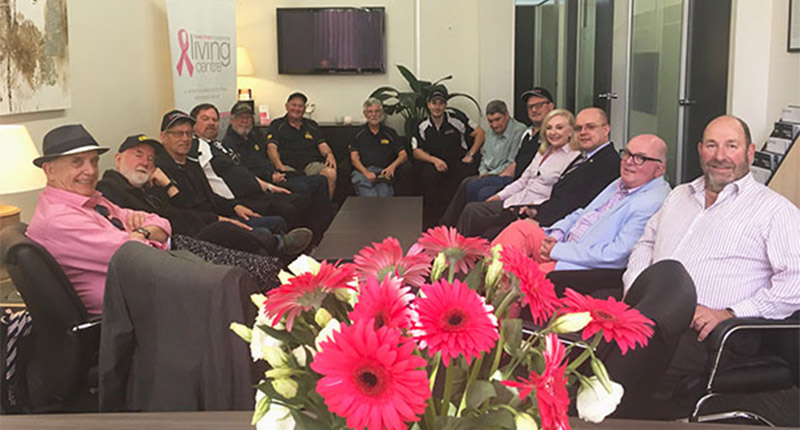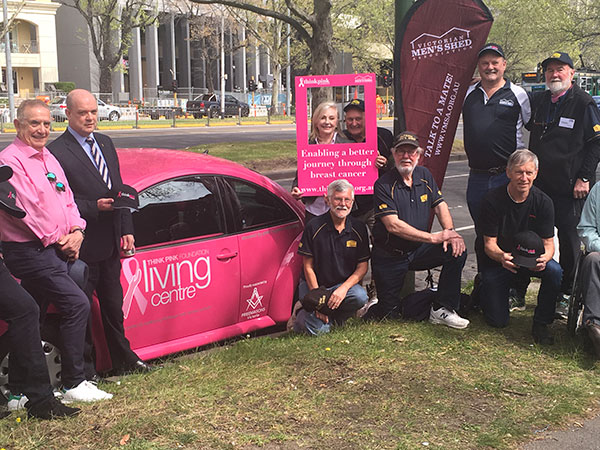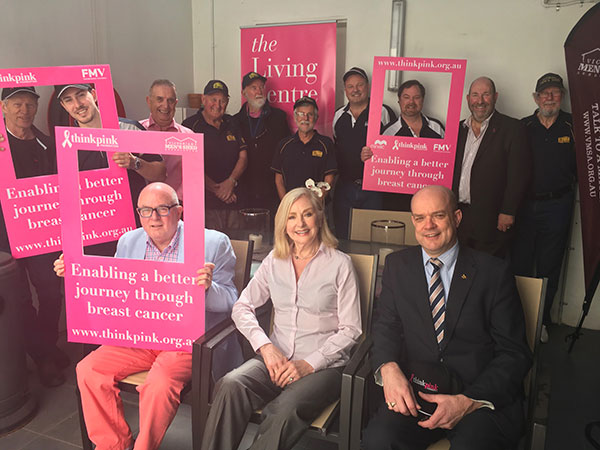The Think Pink Foundation, which provides free support services for women and men with breast cancer in Victoria, has joined forces with the Victorian Men’s Shed Association, one of the fastest growing community organisations in Victoria.

Freemasons Victoria and Freemasons Foundation Victoria Limited, along with Mirvac, have been foundation and major ongoing supporters of The Think Pink Foundation Living Centre. Freemasons Victoria President of the Board of General Purposes, Richard Elkington and Bruce Cowie, Grand Secretary, attended the official launch of the Think Pink Men’s Shed program.
In 2016, approximately 16,084 women were diagnosed with breast cancer nationally with approximately 44 women being diagnosed each day.
Founder and Patron of the Think Pink Foundation Living Centre, Irene Hendel OAM welcomed the announcement saying it would provide a major boost to raising awareness of the Think Pink Foundation’s work in assisting women and men with breast cancer across Victoria, especially those from country and regional areas.
Ron Smith, Chairman of the Think Pink Foundation, who initiated the partnership between the two organisations, said the Men’s Shed Association had been one of the most successful community networks in Australia sharing many synergies with the Think Pink Foundation in supporting the community.
“The popular “supporting blokes’ program for men whose partners have breast cancer has been a great benefit to many men and their families and connects directly with the community work being undertaken by the Men’s Shed.
“As part of the program, members of the Men’s Shed, or a family member who has breast cancer, will be made aware of the free services and the program of activities at the Think Pink Living Centre through the Friends of Think Pink,” Mr Smith said.
|
President of the Victorian Men’s Shed Association, Lindsay Oates from the Mirboo Shed, said being able to access the valuable services of the Think Pink Living Centre and creating an awareness of breast cancer throughout the community will be a valuable positive initiative for our 27,000 members and their families throughout Victoria.
|
The Think Pink Living Centre is a unique state of the art, independent and non clinical wellness centre, which since opening in 2010 has helped hundreds of breast cancer patients and their families.
The Centre’s services include general advice and counselling from a senior breast care nurse, free wig service, tai chi classes, yoga and Pilates classes, art therapy classes, indulgence days of pampering, walking groups, and a ‘supporting blokes’ group. There is also a return to work transitioning program and an emergency accommodation apartment for rural based patients receiving treatment in Melbourne.
Media Enquiries:
Ron Smith, Chairman, Think Pink Foundation – Mobile: 0417 329 201 www.thinkpink.org.au
Ron Smith, Chairman, Think Pink Foundation – Mobile: 0417 329 201 www.thinkpink.org.au
Ric Blackburn, Executive Officer, Victorian Men’s Shed Association – Mobile 0408 465 228
www.vmsa.org.au
www.vmsa.org.au
Background Facts and Figures
- The Think Pink Foundation has been working to provide practical support to breast cancer patients since 2004. In July 2010, we opened our unique Living Centre – providing holistic support, unlimited access to Breast Care Nurses, wig bank, ‘supporting blokes’ program, return to work program and an emergency accommodation apartment for rural based patients receiving treatment in Melbourne – ALL free of charge!
- Breast cancer is the most common cancer diagnosed in women;
- In 2016, approximately 16,084 women were diagnosed with breast cancer nationally;
- Approximately 44 women will be diagnosed each day;
- Statistically, 1 in 8 Australian women will be diagnosed with breast cancer by the time they turn 85;
- It is estimated that in 2020, the number of women diagnosed with breast cancer will exceed 17,210;
- 8 people die from breast cancer each day, meaning that 3073 lost their battle with the disease in 2016.
Source: Cancer Australia website 2016.
Breast cancer in Australia


